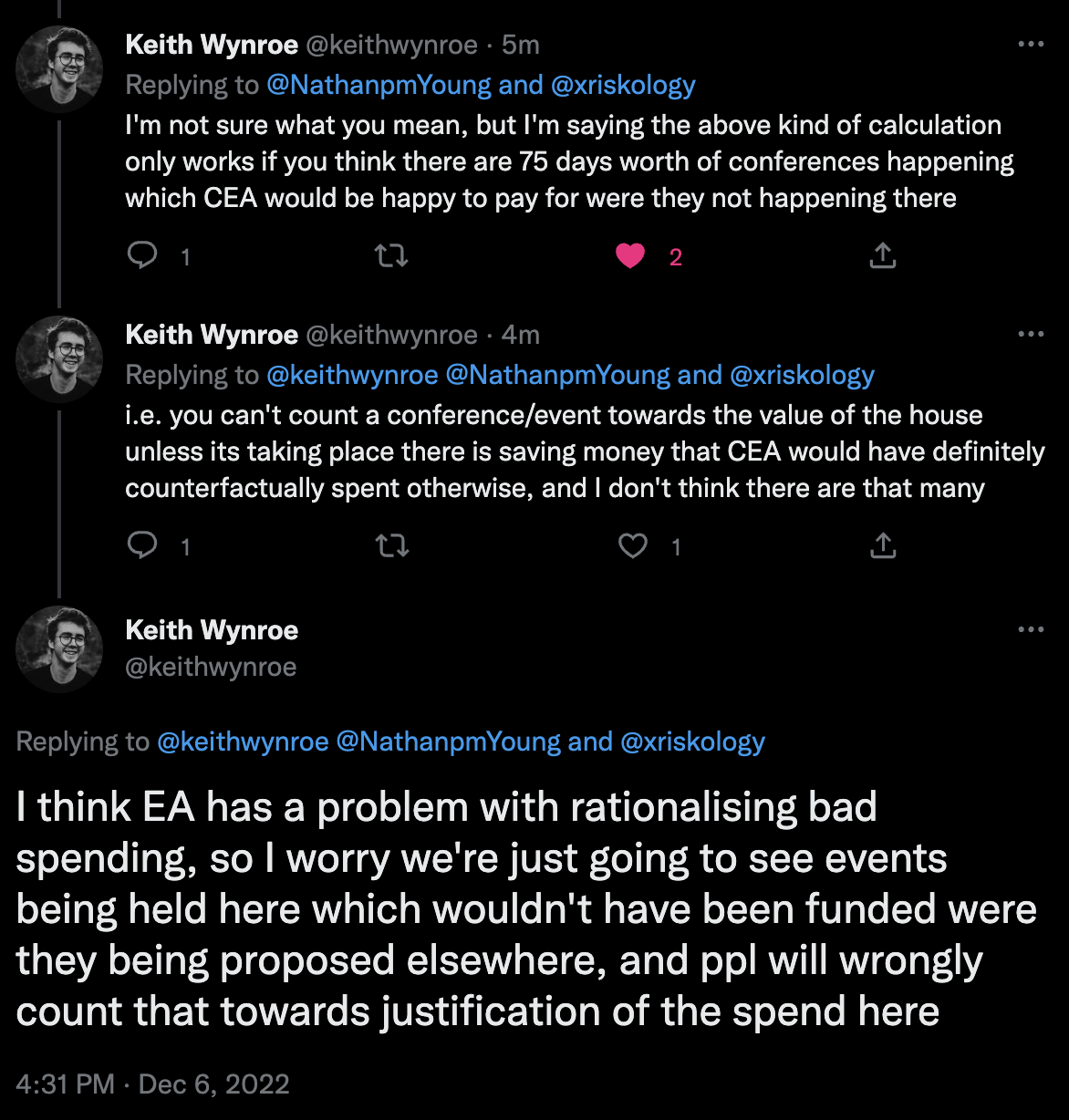Edit to add (9/1/2023): This post was written quickly and I judged things prematurely. I also regret not reaching out to Effective Ventures before posting it. Regarding my current opinion on the Abbey: I don't have anything really useful to say that isn't mentioned by others. The goal of this post was to ask a question and gather information, mostly because I was very surprised. I don't have a strong opinion on the purchase anymore and the ones I have are with high uncertainty. More thoughts in my case for transparent spending.
Yesterday morning I woke up and saw this tweet by Émile Torres: https://twitter.com/xriskology/status/1599511179738505216
I was shocked, angry and upset at first. Especially since it appears that the estate was for sale last year for 15 million pounds: https://twitter.com/RhiannonDauster/status/1599539148565934086
I'm not a big fan of Émile's writing and how they often misrepresent the EA movement. But that's not what this question is about, because they do raise a good point here: Why did CEA buy this property? My trust in CEA has been a bit shaky lately, and this doesn't help.
Apparently it was already mentioned in the New Yorker piece: https://www.newyorker.com/magazine/2022/08/15/the-reluctant-prophet-of-effective-altruism#:~:text=Last year%2C the Centre for Effective Altruism bought Wytham Abbey%2C a palatial estate near Oxford%2C built in 1480. Money%2C which no longer seemed an object%2C was increasingly being reinvested in the community itself.
"Last year, the Centre for Effective Altruism bought Wytham Abbey, a palatial estate near Oxford, built in 1480. Money, which no longer seemed an object, was increasingly being reinvested in the community itself."
For some reason I glanced over it at the time, or I just didn't realize the seriousness of it.
Upon more research, I came across this comment by Shakeel Hashim: "In April, Effective Ventures purchased Wytham Abbey and some land around it (but <1% of the 2,500 acre estate you're suggesting). Wytham is in the process of being established as a convening centre to run workshops and meetings that bring together people to think seriously about how to address important problems in the world. The vision is modelled on traditional specialist conference centres, e.g. Oberwolfach, The Rockefeller Foundation Bellagio Center or the Brocher Foundation.
The purchase was made from a large grant made specifically for this. There was no money from FTX or affiliated individuals or organizations." https://forum.effectivealtruism.org/posts/Et7oPMu6czhEd8ExW/why-you-re-not-hearing-as-much-from-ea-orgs-as-you-d-like?commentId=uRDZKw24mYe2NP4eq
I'm very relieved to hear money from individual donors wasn't used. And the <1% suggests 15 million pounds perhaps wasn't spent. Still, I'd love to hear and understand more about this project and why CEA thinks it's cost-effective. What is the EV calculation behind it?
Like the New Yorker piece points out, with more funding there has been a lot of spending within the movement itself. And that's fine, great even. This way more outreach can be done and the movement can grow. But we don't want to be too self-serving, and I'm scared too much of this thinking will lead to rationalizing lavish expenses (and I'm afraid this is already happening). There needs to be more transparency behind big expenses.
Edit to add: If this expense has been made a while back, why not announce it then?


I'm not going to comment on the emotional/anger/PR side, but here are some numbers for the discussion to be somewhat connected with Oxford conference accommodation reality; speaking just in my personal capacity as someone who did run events in Oxford.
According to the first public price list in my google results, conference accommodation in a college in Oxford in 2020 was >£70 (standard room) + >$45 on meals + >~$1000 for 4 lecture rooms, per day. With a 30 person event, it's >£4500 per day. With 40 ppl and more lecture rooms, it would be more like >£6k/day, just for space and food.
Multiplying it with days per year, it's >£2.2M/y. To get realistic comparisons, you would need to adjust for many other factors sometimes of order 0.3-3x, like occupancy, costs of adjusting venues to your needs, costs of the staff,... In impact calculation, you would also need to adjust for counterfactual loses such as "not able to run an event because everything good is either booked a year in advance, or even more expensive than the college price list" where having a friendly venue can cause the event to counterfactually happen at all.
I noted the same in the following sentence: To get realistic comparisons, you would need to adjust for many other factors sometimes of order 0.3-3x, like occupancy, costs of adjusting venues to your needs, costs of the staff,...
For example, if you use your venue 65% of time, you should multiply the mentioned figure by 0.65.
What's pushing in the opposite direction is for example this: if you use a rented venue, and often spend 1-2 days before and 1 day after the event on setting it up according to your needs / returning to original state, you need to accoun... (read more)